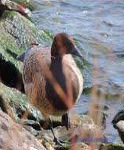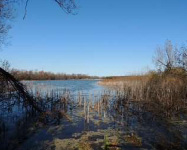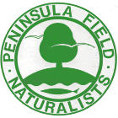President's Observations
On October 18, 2014, members of the Peninsula Field Naturalists were treated to a fall tour of the Irish Grove Woodlot. It threatened rain that morning but luckily it held off and Bruce Mackenzie, former President of the Hamilton Naturalists' Club, was there to inform us of the importance of a woodlot that is an excellent example of original Carolinian forest. We walked through the woodlot admiring the tall White Pines, Shagbark and Bitternut Hickory, and the large Red and White Oaks. Our group observed the re-growth in the expropriated portion of the forest, the only sign of human interference being a utility-hole cover installed about 40 years ago.
In early January, a new species of tree was discovered. There are a few Red Hickories in the woodlot including a specimen that is estimated to exceed 210 years of age. If the proposed road extension is allowed to continue, it would devastate the ecology of the largest woodlot in Grimsby below the Niagara Escarpment. The impressive Red Oaks situated near the planned extension would not survive.
The PFN have voiced their concerns to the Niagara Region and Bruce Mackenzie's article informs us all on how important a letter can be. The article appeared in the January issue of The Wood Duck and can be found on the PFN website for our members to read. Thanks to Ja Irish, the woodlot owner, I will lead a spring outing on Saturday, April 25, 2015, and I hope to see many of you there. I'm looking forward to the flowers and migrating birds we will find.
At the time of composing this article, the PIC regarding the road extension has still not been scheduled. As soon as we are informed of a meeting concerning the future of the Irish Grove Woodlot, we'll let our members know. I strongly agree with Bruce. Your voice is needed now. Join the Save The Woodlot Facebook page to show your support. I'll continue to update the PFN Facebook page with information on the woodlot. Send a letter to the municipal and provincial governments. Let the elected officials know that you care and that the Greenbelt and NEC should not be altered to favour development. Our future generations will thank you.
MUD LAKE OUTING
On November 2, 2014, we once again ventured to Mud Lake Conservation Area in Port Colborne for a Club outing. Bob and I had planned to guide the group on a 1km hike of part of the trail around the lake but because the weather was so accommodating and everyone was bursting with energy, we decided to hike the entire 3.1 km trail. We were glad we had. One member had expressed interest in seeing a Hairy Woodpecker and he got his wish! We saw four! We also saw a lovely Red-Bellied Woodpecker ,a nice mixed flock of Chickadees and Golden-Crowned Kinglets and our first Tree Sparrow of the Fall. We would like to hold this walk earlier in the fall for 2015 in the hopes that we can find more migrating waterfowl. Hope to see you there! By Jean Hampson (see photo on p.3)
BIRDING NORTHERN PERU by John Black and Marcie Jacklin
Monday, October 27, brought the PFN a presentation by John and Marcie entitled "Birding Northern Peru". Their trip, planned to be from Feb.10-23, 2014 , was partially facilitated by the presence of birding friends Dan Salisbury and Roberta McKenzie, who were in Peru and had some useful connections and contacts in that country. Dan set up a vehicle and driver locally and compiled a list of places to visit, based on the work of Thomas Valqui ‘s book Where to Watch Birds in Peru 2004. John, Marcie, and Tim Seeburn had the book Birds of Peru 2010 Revised from the original 2006 edition by Schullenberg, Stotz, Lane, O’Neill and Parker.
There are about 10,000 species of birds in the world and almost 1900 of them can be found in Peru. Dan Salisbury has seen over 7000 species of birds in his travels; he was hoping to see a Stygian Owk. John decided in 1980 to concentrate on seeing the world's 175 bird families. Now ornithologists think there are about 240 families so John's quest to see all the bird families is thwarted every time they introduce a new one. John's target families on this trip were Crescentchests, Sharpbill, Plushcap, Short-tailed Field Tyrant and Peruvian Plantcutter, all possible in northern Peru.
The travel plan for their trip was basically to fly from Toronto to Lima, Peru; take a local flight northeast from Lima to Tarapoto; drive from Tarapoto to Moyobamba; drive over the Andes to Florida de Pomacochas, Jaen, Olmos and to Chiclayo on the Pacific coast; back to Pomacochas; back to Tarapoto; flight to Lima; flight to Toronto. Much of the road travel from Tarapoto west to the coast and south to Chiclayo and back was through mountainous high-elevation country of 2000 -3000 meters above sea-level. The group were frequently up at 0400-0500 hrs , and sometimes going to bed around 2000-2300 hrs. John's comment: "As a group we saw and/or heard over 500 species of birds. I saw all target birds except the Sharpbill and added 165 lifers." Dan did see his Stygian Owl. Marcie also saw an Andean Condor. The group's list of animals and birds seen follows:
Animals: Saddlebacked Tamarin; Night Monkey; Brazilian Tapir; Tiger Rat Snake (7 feet long)
Birds:
Oilbirds, Hummingbirds (sp. include Marvelous Spatulatail; Royal Sunangel;
Amethyst Sunangel; Purple- throated Sunangel; Sword-billed Hummingbird; Koepke
Hermit Hummingbird; Gould’s Jewelfront Hummingbird; Amethyst Woodstar
Hummingbird; Spot-throated Hummingbird); Masked Duck, Thornbird, Fierythroated
Fruiteater, Stygian Owl, Blackish Nightjar, Scissor-tailed Nightjar,
Vermiculated Screech Owl, Elaenia, Black Agouti, Taigra, Bar-winged Wren,
Long-whiskered Owl, Rusty-tinged Antpitta, Pale-billed Antpitta, Unstreaked
Tit-tyrant, Blue-winged Mountain Tanager, Black-capped Hemispingus, Plushcap,
House Wren, American Kestrel, Blue-capped Tanager, Andean Guan, Masked Saltator,
Burnished Buff Tanager, Andean Emerald, Little Woodstar, Comb Duck, Savannah
Hawk, Maranon Thrush, Squirrel Cuckoo, Blue-black Grassquit, Silverbeak Tanagers
, White-tipped Dove, Saffron Finch, Southern Beardless Tyrannulets, Bran Colored
Flycatcher, Chinchipe Spinetail, Pale-legged Hornero, Chestnut-throated
Seedeater, Social Flycatcher, Streaked Saltator, Ecuadorian Ground Dove, Little
Inca-Finch, Tawny-crowned Pygmy Tyrant, Long-tailed Mockingbird, Eared Dove,
White-tipped Dove, Groove-billed Ani, Green Jay, Collared Antbird, Maranon
Crescentchest, Maranon Spinetail, Maranon Slaty-Antshrike, Maranon Thornbird,
Peruvian Pygmy Owl, Peruvian Meadowlark, Elegant Crescentchest, Ash-breasted
Sierra-Finch, White-browed Brush Finch, Piura Chat-Tyrant, White-winged Guan,
Henna-hooded Foliage Gleaner (heard only), Watkin’s Antpitta (heard only),
Guayaquil Woodpecker, Peruvian Plantcutter, Peruvian Pelican, Oystercatcher,
Sooty Shearwater, Gray-headed Gull, Franklin’s Gull, Laughing Gull, Gray Gull,
Kelp Gull, Magnificent Frigatebird, Snowy Plover, Boobies, Peruvian Pelican,
Painted Crake, Spotted Rail, Yellowish Pipit, Burrowing Owl, Short-tailed Field
Tyrant, Many-coloured Rush Tyrant, Long-whiskered Owlet, Vermillion Tanager,
Paradise Tanager, Purpletuft, Cliff Flycatcher.
IN SEARCH OF THE PURPLE SANDPIPER By Bob Highcock
On November 9, 2014, members of the PFN joined John Black at 0830 hours for a morning walk along the East Pier in Port Weller. It was cool but sunny as we walked along the old Seaway Haulage Road. A lone Mute Swan was spotted in the Welland Canal. Our group saw Chickadees, Robins and Cedar Waxwings moving through the trees. Further along the road, we all had great views of a pair of Peregrine Falcons. At the tip we observed a Red-throated Loon flying towards the west and a flock of Snow Buntings flew overhead as we walked toward the beacon. Waterfowl observed included Long-tailed Ducks, Bufflehead and Red-breasted Mergansers. One member of our group had a quick view of a Purple Sandpiper before it took flight from the rocks on the lake side of the spit. Happily, though, on the bay side the entire group had an excellent view of a Brant ( below).
Returning along the footpath on the east side of the pier, more waterfowl were found. Species observed included Hooded Merganser, Gadwall, Ruddy Duck, Canvasback, and Greater Scaup. The walk lasted 2.5 hours and we observed a total of 33 species. The group then continued on to explore the west pier and we observed the same pair of Peregrine Falcons sitting at the entrance to the canal . (Note: this is the third year we have searched for and, though brief, the first year to observe Purple Sandpiper.)
Photos:- Brant on left & Mud Lake in center by Jean Hampson; CBC Roundup dinner by Rick Young



Owls of Southern Ontario
When an intended Speaker becomes unavailable for a PFN meeting, a replacement is usually found. When the intended speaker on Indian Directional Trees could not appear on Nov. 24, John Potter filled in with a slide- presentation on "The Owls of Southern Ontario". Thanks to information provided by the technical staff at the Owl Foundation (TOF), this talk included photos of all the owl spcies housed at the Foundation, with details about where they nest, how they hunt, and what body parts of owls are modified to assist them in their hunting. The TOF staff also included in the talk the variety of sounds that several of the owl species can make, of which some sounds are similar to barking dogs, while others are the classical 'whoo-whoo' sounds. The talk included the Screech Owls, Great Horned Owls, Long-eared Owls, Short-eared Owls, and Northern Saw-whet Owls which live in Southern Ontario, as well as the more-northern species such as Great Grey Owls, Barred Owls, Hawk Owls, Snowy Owls, and the extirpated Barn Owls. The Barn Owl is a sad case, since their habitat is mainly gone - no barns, no haylofts to nest in, few fields of pasture or hay where mice would flourish. The talk closes with advice on how to help owls avoid being hit by vehicles - simply , don't throw foodscraps on roadsides where mice may congregate. John has presented this talk to several schools, seniors' groups, at Heartland Forest, and recently at the Niagara Falls Museum where a ROM show on owls is currently open from January-April 2015.
St. Catharines Christmas Bird Count , December 14, 2014 - By Marcie Jacklin
The Peninsula Field Naturalists held their Christmas Bird Count on December 14, 2014. The weather was mild for mid-December with the thermometer hovering slightly above zero on a cloudy day. The 52 participants included 4 children. The results show that everyone on the count contributes to the success of this count. We collectively spent 109 hours counting and walked or drove 559.3 km. We tallied 88 species plus one on count week (Red-headed Woodpecker). This is well above the average of 76. We tallied 30,303 individuals, which is the highest number of individuals since 1997.
A big THANK YOU once again to Mary and John Potter for organizing this years round-up party, and to all who helped set up, clean up and brought very yummy food to the round up. It was very much appreciated.
Three new species were added to the count – Cackling Goose (2), Trumpeter Swan (1), and Harris’s Sparrow (1). Lone Ruddy Duck, Pileated Woodpecker and Rusty Blackbird were all second records for the count. A lone Peregrine Falcon was the third record for the count. A count of 5 Snowy Owls and 44 Ring-necked Ducks (tie) were record high counts. A count of 122 Downy Woodpeckers is the highest count in 19 years. A count of 760 Long-tailed Ducks is the highest count in the past decade as was 13 Horned Grebes. A count of 4 Great Scaup is the lowest count in the last decade and a count of 11 Cedar Waxwings was the lowest count in 25 years. A nice surprise was the Northern Goshawk.This year we had 52 participants:- Brian Ahara, Jesse Barraza, John Black, Peter BonEnfant, Paul Chapman, Sue Chapman, Barb Charlton, Paula Clark, Emily Cornfield, Rachael Cornfield, Trevor Cornfield, Carl Damude, Janet Damude, Don Dimond, Elaine Dimond, Rob Dobos, Philip Downey, Ben Escott, Chris Escott, Denys Gardiner, Elliot Gillespie, Joseph Gillespie, Sarah Gillespie, Steve Gillis, Linda Glover, Jean Hampson, Bob Highcock, Carol Horvat, Marcie Jacklin, Nabil Khairallah, Ramsey Khairallah, Kara Kristjanson, Win Laar, Bob Manson, Don Mills , Gisele Mills, Judy Robins, Kayo Roy, Marlene Sanders, Joyce Sankey, Tim Seburn , Karin Schneider, Dave Smith, Nancy Smith, Pat Smith, Roy Sorgenfrei, John Stevens, Katherine Stolz, Chris Street, Tom Thomas, Heather VanVolkenberg, Rick Young. Many thanks to all participants!
| Snow Goose | 1 |
| Cackling Goose | 2 |
| Canada Goose | 3717 |
| Mute Swan | 8 |
| Trumpeter Swan | 1 |
| Wood Duck | 1 |
| American Black Duck | 22 |
| Mallard | 470 |
| Northern Pintail | 1 |
| Redhead | 1 |
| Ring-necked Duck | 44 |
| Greater Scaup | 4 |
| White-winged Scoter | 57 |
| Long-tailed Duck | 760 |
| Bufflehead | 52 |
| Common Goldeneye | 157 |
| Hooded Merganser | 47 |
| Common Merganser | 191 |
| Red-breasted Merganser | 76 |
| Ruddy Duck | 1 |
| Ring-necked Pheasant | 3 |
| Wild Turkey | 16 |
| Red-throated Loon | 5 |
| Common Loon | 2 |
| Horned Grebe | 13 |
| Double-crested Cormorant | 30 |
| Great Blue Heron | 3 |
| Turkey Vulture | 1 |
| Bald Eagle | 2 |
| Northern Harrier | 1 |
| Sharp-shinned Hawk | 5 |
| Cooper’s Hawk | 14 |
| Northern Goshawk | 1 |
| Red-tailed Hawk | 167 |
| Rough-legged hawk | 1 |
| American Coot | 10 |
| Bonaparte’s Gull | 27 |
| Ring-billed Gull | 539 |
| Herring Gull | 171 |
| Great Black-backed Gull | 23 |
| Gull species | 108 |
| Rock Pigeon | 770 |
| Mourning Dove | 1437 |
| Eastern Screech-owl | 10 |
| Great Horned Owl | 6 |
| Short-eared Owl | 2 |
| Snowy Owl | 5 |
| Belted Kingfisher | 2 |
| Red-bellied Woodpecker | 60 |
| Downy Woodpecker | 122 |
| Hairy Woodpecker | 18 |
| Northern Flicker | 20 |
| Pileated Woodpecker | 1 |
| Woodpecker species | 1 |
| American Kestrel | 38 |
| Merlin | 1 |
| Peregrine Falcon | 1 |
| Blue Jay | 570 |
| American Crow | 87 |
| Horned Lark | 6 |
| Black-capped Chickadee | 343 |
| Tufted Titmouse | 6 |
| Red-breasted Nuthatch | 9 |
| White-breasted Nuthatch | 44 |
| Brown Creeper | 6 |
| Winter Wren | 5 |
| Carolina Wren | 26 |
| Golden-crowned Kinglet | 10 |
| Eastern Bluebird | 86 |
| American Robin | 412 |
| Northern Mockingbird | 50 |
| European Starling | 14944 |
| Cedar Waxwing | 11 |
| American Tree Sparrow | 485 |
| Song Sparrow | 10 |
| Swamp Sparrow | 3 |
| White-throated Sparrow | 14 |
| Harris’s Sparrow | 1 |
| White-crowned Sparrow | 16 |
| Dark-eyed Junco | 1142 |
| Lapland Longspur | 1 |
| Northern Cardinal | 320 |
| Red-winged Blackbird | 1 |
| Rusty Blackbird | 1 |
| Brown-headed Cowbird | 7 |
| House Finch | 308 |
| Common Redpoll | 2 |
| Pine Siskin | 7 |
| American Goldfinch | 364 |
| House Sparrow | 1756 |
1 Red-headed Woodpecker seen during Count Week.

Lake Ontario Midwinter Waterfowl Inventory
The inventory followed the system used in previous years. The participants covered the shoreline from 50-Point to Niagara-on-the-Lake, with the exception of walking the east and west sides of the Port Weller piers, which extend out about 1 km into the lake from the shore and protect the Welland Canal from wave action. They also observed ducks in the old Canal from Lakeshore Road out into the lake at Port Dalhousie, not necessary to walk out on the piers. John Black, for the first time ever, missed the count because of flu.
Total party hours from 50 Point to Niagara-on-the-Lake = 15.5. Total person-hours from 50 Point to Niagara- on-the-Lake = 45. Participants were: Brian Ahara; Drew Campbell; Paula Clark; Philip Downey; Blayne Farnan; Jean Farnan; Jean Hampson; Bob Highcock; Carol O'Shea; Kayo Roy; Marlene Sanders.
| Niagara Location | 2014 | 2015 |
|---|---|---|
| SPECIES | Total | Total |
| Common Loon | 0 | 0 |
| Pied-billed Grebe | 0 | 0 |
| Horned Grebe | 1 | 1 |
| Red-necked Grebe | 0 | 0 |
| Double-crested Cormorant | 13 | 2 |
| Tundra Swan | 7 | 0 |
| Trumpeter Swan | 0 | 0 |
| Mute Swan | 5 | 0 |
| Snow Goose | 0 | 0 |
| Canada Goose | 2205 | 1580 |
| Wood Duck | 0 | 0 |
| Green-winged Teal | 0 | 0 |
| American Black Duck | 9 | 37 |
| Mallard | 818 | 753 |
| Northern Pintail | 0 | 0 |
| Northern Shoveller | 0 | 0 |
| Gadwall | 0 | 0 |
| American Widgeon | 0 | 0 |
| Canvasback | 2 | 1 |
| Redhead | 2 | 16 |
| Ring-necked Duck | 2 | 0 |
| Tufted Duck | 0 | 0 |
| Greater Scaup | 353 | 1802 |
| Lesser Scaup | 4 | 1 |
| Scaup (sp.) | 31 | 0 |
| Harlequin duck | 0 | 0 |
| Long-tailed Duck | 4986 | 22765 |
| Black Scoter | 0 | 0 |
| White-winged Scoter | 1319 | 1186 |
| Surf Scoter | 0 | 0 |
| Common Goldeneye | 2422 | 2729 |
| Bufflehead | 715 | 529 |
| Hooded Merganser | 0 | 1 |
| Common Merganser | 233 | 535 |
| Red-breasted Merganser | 3124 | 1328 |
| Ruddy Duck | 0 | 0 |
| American Coot | 11 | 2 |
| Red-throated Loon | 9 | 4 |
| King Eider | 0 | 0 |
| Unknown Merganser | 30 | 0 |
| Unknown | 8445 | 200 |
| Bald Eagle (Adults) | 3 Ad | 9 |
| Snowy Owl | 10 | 0 |
Niagara Falls Water Treatment Plant Tour; November 30, 2014
This tour was offered by PFN member Ed Skala, one of the technicians responsible for keeping the tap-water for Niagara Falls and surroundings safe and pure. A party of 9 members were on hand for the tour, curious and camera-equipped. As soon as Ed led us through the front door of the building, the sight of several giant pumps made it clear that the water plant was built to do its job of purifying water - LOTS of water! We quickly discovered also that it was wise to stay close to the leader, as our tour included many turns and climbs up or down stairs.
A large part of the building contained long deep tanks through which the water slowly flowed, while the sediment that it carried was gradually filtered out and settled at the bottom of the tanks. The settling is assisted by adding aluminum sulphate (a chemical coagulant). The sludge that settles out is pumped into a sludge holding-tank, and later to the sanitary sewer or to a sludge disposal truck, while water from the sludge-tank is dechlorinated and returned to the Niagara River below the plant intake.
The water being cleaned was then filtered through granulated carbon filters, and next was passed by quartz tubes, each containing four UV fluorescent tubes, which treated the water by UV radiation. As a final treatment, a small amount of chlorine is added to the water before it leaves the plant and goes to the residents and industries in the city. Ed showed us the lab where he and a fellow worker, Kirby, explained the tests that they perform on the finished water to make sure that it meets the proper standards. Also, we were shown the computer system which controls the plant, with a console at which the operator on duty can run the entire plant by pushing buttons, and at which he can check any abnormality in the operation.
Other significant facts: Two main water treatment plants (Niagara Falls and Decew Falls) supply the water for the area from Chippawa to Vineland. Both major plants draw their water from Lake Erie. In addition, smaller plants at Grimsby, Welland, Fort Erie and Port Colborne provide the water for the rest of Niagara. Each main treatment plant has several re-chlorination stations along the water transmission lines, strategically located to ensure sufficient disinfection of drinking-water before it reaches the municipalities.
(Thanks to Ed Skala for reading the draft and clarifying technical details, as well as leading the tour! The photo on the following page shows Ed (on the right) explaining to the 'tourists' what is happening in the settling tanks.
Thanks to Jean Hampson for this photograph, and for others in this issue of the newsletter. Thanks also to Rick Young for the group photo of the Christmas Bird Count gang, on page 5. How did the man in the grey sweat- shirt manage to take the photo and also appear in it? Curious minds would like to know...)

"Your Letters Count"
On the Peninsula Field Naturalists website, you will find a "Woodlot Letter", written by Bruce MacKenzie. Bruce is a Past-President of the Hamilton Naturalists Club, an ardent naturalist whom some of you know because of his struggle to preserve the Irish Woodlot in Grimsby, and a determined environmentalist. The PFN Board encourages you to read and reflect on Bruce's letter on the website, and then respond to the Provincial Government stating your concerns regarding the review of the Greenbelt Plan and the Niagara Escarpment Plan.

The Peninsula Field Naturalists Club
A non-profit organization started in 1954 with the objectives to preserve
wildlife and protect its habitat, to promote public interest in and a knowledge
of the natural history of the area, and to promote, encourage and cooperate with
organizations and individuals having similar interests and objectives.
Affiliated with Ontario Nature and Nature Canada.
P.O. Box 23031, RPO Carlton, St. Catharines, ON. L2R 7P6
Website : peninsulafieldnats.com
The Peninsula Naturalist
Published: February, April/May, October/November
The Editor welcomes written articles or artwork on any natural history topic.
Please submit typed reports on paper or by email to: jmpotter068@gmail.com
Colour photos (jpg) accompanying articles are welcome. All pieces of artwork
will be accepted. New ideas and constructive criticism are welcome. Please send
submissions by email to e-address above, or by snail-mail to the Club’s postal
address.
Editor: John Potter
Assistant: Mary Potter
–
The Peninsula Naturalist Newsletter,
Published: February, April?; October/November
Download the complete newsletter pdf
